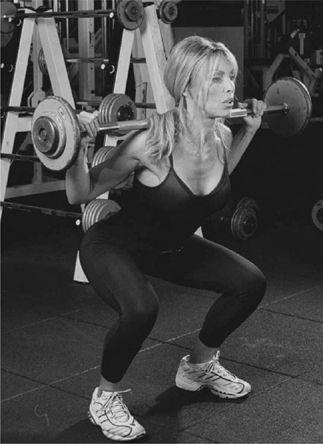The Body Sculpting Bible for Women (26 page)
Read The Body Sculpting Bible for Women Online
Authors: James Villepigue,Hugo Rivera
Tags: #Health & Fitness, #Exercise, #General, #Women's Health

FAQ:
I have a bad back and I’ve heard that you can seriously injure your back performing this exercise
.
ANSWER:
Squats are one of the greatest compound movements you can do for your entire body. When performed correctly, it will bring you great results. When done improperly, the squat will give you, well, squat! Here’s the distinction: many people are injured when they try this with incorrect form or go overboard. Going overboard includes using too heavy of a weight, and not taking enough time or taking too much rest time between sets.
Recent research found that back injuries are often the result of poor lower back muscular endurance, in other words, the back’s ability to hold and maintain a muscular contraction. To beef up your lower back’s muscular endurance, perform exercises that concentrate on your balance and coordination, like the Lunge, Abdominal Crunch on the Ball, and other rotational exercises.
Dumbbell Squat
For a change of pace you might want to alternate between the barbell squat and the dumbbell squat. Both are very similar exercises in that they emphasize the same muscle groups, but each one has its benefits. With the barbell squat you can use more weight because you don’t have to hold on to dumbbells. The dumbbells do make it easier to focus on your form, though, and once you begin to experience muscle fatigue, you can simply drop the dumbbells and still continue to squat without weight.
PROPER ALIGNMENT
 Hold a dumbbell in each hand with arms extended down and palms facing your body.
Hold a dumbbell in each hand with arms extended down and palms facing your body.
 Align your body from the bottom up by first taking a shoulder-width stance.
Align your body from the bottom up by first taking a shoulder-width stance.
 Slightly bend your knees and avoid locking them during this exercise.
Slightly bend your knees and avoid locking them during this exercise.
 Contract your abdominal muscles to help support and sustain your posture during the exercise.
Contract your abdominal muscles to help support and sustain your posture during the exercise.
 Stick your chest out and simultaneously bring your shoulder blades back, keeping them there throughout the movement.
Stick your chest out and simultaneously bring your shoulder blades back, keeping them there throughout the movement.
 Keep your head level at all times, making sure your head or your eyes do not drop down, or excessively wander upward. This is an easy way to lose your balance and fall. It is preferable to look slightly above level rather than below because looking below level can greatly affect your equilibrium and jeopardize your safety.
Keep your head level at all times, making sure your head or your eyes do not drop down, or excessively wander upward. This is an easy way to lose your balance and fall. It is preferable to look slightly above level rather than below because looking below level can greatly affect your equilibrium and jeopardize your safety.
 If you feel unstable, you may put small two pound plates under each heel for stability.
If you feel unstable, you may put small two pound plates under each heel for stability.
TECHNIQUE AND FORM
 When you think you have properly aligned yourself, repeat the alignment steps starting from the bottom and moving up. Once you have secured your alignment, prepare to inhale as you begin your descent.
When you think you have properly aligned yourself, repeat the alignment steps starting from the bottom and moving up. Once you have secured your alignment, prepare to inhale as you begin your descent.
 As you are squatting downward, it is very important that at no time throughout the movement do your knees go beyond your toes. This puts way too much pressure on the knees and can seriously damage them. Here is a technique that will help prevent this from happening: As you begin your descent, mimic the motion and alignment of sitting in a chair. Make sure you keep your back as straight as possible. This motion will naturally help you utilize the proper form.
As you are squatting downward, it is very important that at no time throughout the movement do your knees go beyond your toes. This puts way too much pressure on the knees and can seriously damage them. Here is a technique that will help prevent this from happening: As you begin your descent, mimic the motion and alignment of sitting in a chair. Make sure you keep your back as straight as possible. This motion will naturally help you utilize the proper form.
 Make sure you don’t let your thighs go below horizontal as you could injure your lower back; and this can also push the knees past the toes, once again leading to injury.
Make sure you don’t let your thighs go below horizontal as you could injure your lower back; and this can also push the knees past the toes, once again leading to injury.
 As you reach horizontal or just above it, begin to exhale and press off your feet, distributing the weight through the heel while pressing upward. Concentrate on keeping and holding proper alignment throughout the movement.
As you reach horizontal or just above it, begin to exhale and press off your feet, distributing the weight through the heel while pressing upward. Concentrate on keeping and holding proper alignment throughout the movement.

